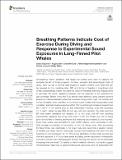Breathing patterns indicate cost of exercise during diving and response to experimental sound exposures in long-finned pilot whales
Abstract
Air-breathing marine predators that target sub-surface prey have to balance the energetic benefit of foraging against the time, energetic and physiological costs of diving. Here we use on-animal data loggers to assess whether such trade-offs can be revealed by the breathing rates (BR) and timing of breaths in long-finned pilot whales (Globicephela melas). We used the period immediately following foraging dives in particular, for which respiratory behavior can be expected to be optimized for gas exchange. Breath times and fluke strokes were detected using onboard sensors (pressure, 3-axis acceleration) attached to animals using suction cups. The number and timing of breaths were quantified in non-linear mixed models that incorporated serial correlation and individual as a random effect. We found that pilot whales increased their BR in the 5-10min period prior to, and immediately following, dives that exceeded 31m depth. While pre-dive BRs did not vary with dive duration, the initial post-dive BR was linearly correlated with duration of >2 min dives, with BR then declining exponentially. Apparent net diving costs were 1.7 (SE 0.2) breaths per min of diving (post-dive number of breaths, above pre-dive breathing rate unrelated to dive recovery). Every fluke stroke was estimated to cost 0.086 breaths, which amounted to 80-90% average contribution of locomotion to the net diving costs. After accounting for fluke stroke rate, individuals in the small body size class took a greater number of breaths per diving minute. Individuals reduced their breathing rate (from the rate expected by diving behavior) by 13-16% during playbacks of killer whale sounds and their first exposure to 1-2kHz naval sonar, indicating similar responses to interspecific competitor/predator and anthropogenic sounds. Although we cannot rule out individuals increasing their per-breath O2 uptake to match metabolic demand, our results suggest that behavioral responses to experimental sound exposures were not associated with increased metabolic rates in a stress response, but metabolic rates instead appear to decrease. Our results support the hypothesis that maximal performance leads to predictable (optimized) breathing patterns, which combined with further physiological measurements could improve proxies of field metabolic rates and per-stroke energy costs from animal-borne behavior data.
Citation
Isojunno , S , Aoki , K , Curé , C , Kvadsheim , P & Miller , P 2018 , ' Breathing patterns indicate cost of exercise during diving and response to experimental sound exposures in long-finned pilot whales ' , Frontiers in Physiology , vol. 9 , 1462 . https://doi.org/10.3389/fphys.2018.01462
Publication
Frontiers in Physiology
Status
Peer reviewed
ISSN
1664-042XType
Journal article
Description
This work was funded by NL Ministry of Defence, NOR Ministry of Defence, United States Office of Naval Research (N00014-08-1-0984, N00014-10-1-0355, and N00014-14-1-0390), and FR Ministry of Defence (DGA) (public market n°15860052). KA was supported by the Japan Society for the Promotion of Science Bilateral Open Partnership Joint Research Program.Collections
Items in the St Andrews Research Repository are protected by copyright, with all rights reserved, unless otherwise indicated.

